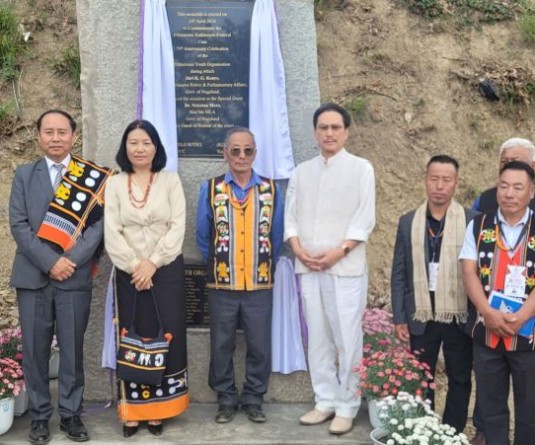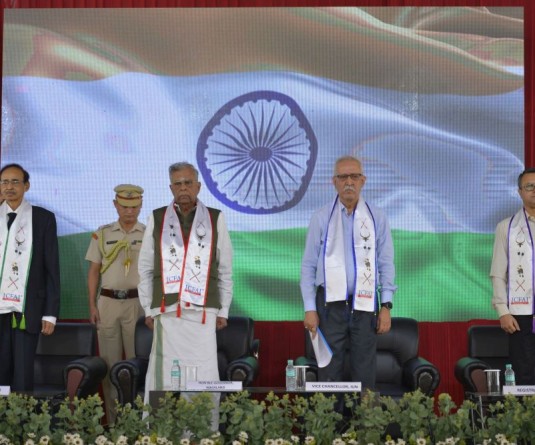
Dimapur, May 3 (MExN): The NSCN (K) today has maintained that it “unilaterally withdrew” from the Indo-Naga ceasefire and the “whims and inclination” of India’s Ministry of Home Affairs to re-enter into a ceasefire with the NSCN (K) “does not arise at all.”
The NSCN (K), in a press note from Col. Isak Sumi, MIP, asserted that it is “fully prepared” to face any eventuality. This came in the backdrop of MHA officials claiming that the Indian government has no plans to re-enter a ceasefire with the NSCN (K) and that “counter insurgency” operations against the group will continue.
Systematic violence
Reminiscing the years of State-sponsored violence from the 1950s up to the 1990s, the long note from the NSCN (K) stated that those “tormenting nightmares” are resurfacing again with the branding of the NSCN (K) as a terror outfit, thereby indicating that the Government of India (GoI) is “determined to trample and stamp out Naga’s rights and aspiration” through similar methods. To that effect, the GoI has enacted and promulgated laws like Unlawful Activities Prevention Act, Prevention of Terrorist Activities Act, Disturbed Area Act, Armed Forces Special Power Act (AFSPA), National Security Act etc in the Naga country “without any regard or conformity to international human rights norms, Geneva convention on the rights of Indigenous people to self determination.”
More than 50 NSCN workers, following alleged torture, are “being held in various prisons across India booked under indefinite non-bailable terrorist acts,” informed the NSCN (K). This reflects, stated the NSCN (K), “India’s continued armed aggression.”
History
The NSCN (K) recalled historical events that led to an “unending reign of terror” following the ‘arbitrary’ partition of the Naga country without the consent of the Nagas in 1953.
Through the “deceitful” Sixteen Point Agreement/Memorandum of 1960, a “tiny state” of Nagaland “comprising of only 1/3rd of total Naga population and territory was carved out as 16th state of Indian union and the rest of the Naga population and ancestral domains were further sub-divided and scattered to various Indian states thus reducing the Nagas to minorities in our own land under the domination of the majority non-Nagas ruled administrative divisions,” recalled the NSCN (K).
Pointing out the human rights violations heaped on the Naga people by Indian Armed Forces, the NSCN (K) maintained that due to complete press/media censorship, the world was never made to know of these incidents.
New age policies
The Naga “passion for freedom could never be contained,” the NSCN (K) observed and said “the Naga struggle grew from strength to strength.” It pointed out that many Indian Army generals and commanders acknowledged the issue as political requiring political solution.
However, money, alcohol and related campaigns were poured in through “Indian politicians/administrators and Indian Army’s Military Civic Action/Army Development Group/Samaritans etc in the form of endowing small community civic facilities such as ring well, school and community halls, furniture, stationers and other minor developmental initiatives.”
The NSCK (K) observed that despite huge natural resources, no genuine industrialisation programmes and policies were ever initiated in the Naga areas. Nagas have been made to “desperately rely on” government jobs and salaries. Not a single mass employing industries and factories have been established in Naga territories, increasing dependence on the GoI.
Often, Naga political groups are blamed for these “failures and negligence,” whereas the bulk of corruption is committed by “India appointed bureaucrats and puppet state politicians.”
The NSCN (K) further alleged that after “forcing” Naga youths to desperation through the “India generated employment crisis,” these youths are mass recruited into India Army and other central and state para-military and police to portray “pro-India stance of the Nagas.”
Besides, the “state of negligence, lack of development” coupled with lack of self-employment and jobs has forced many Naga youth to migrate to other industrialised states resulting in “huge brain drain thus depriving the Nagas of contributions from indigenous and local potentials in overall growth and development.”
Ceasefire politics
“When terror and brutality failed, treacherous politics of division was put into play firstly in the form of cease-fire and political negotiation,” the MIP noted. “Unnecessary and intentional delay tactics” led to division and frustration among Naga political groups, policies which were applied all the way to 2015.
While “several splinter groups” continue to “bask in the comforts and pleasures of India sponsored and dictated ceasefires,” espousing settlement within the Indian Constitution, the SS Khaplang led NSCN is “upholding the independent sovereign legacy of the Nagas” by unilaterally abrogating the 14-year “unproductive exercise” through which GoI “fully intended to effect further political capitulation,” stated the press note.
“The bold historical step taken by NSCN/GPRN should be a celebrated event to every freedom loving Naga since it reaffirms the maturity of the Naga’s struggle and reiterates that Nagas cannot be taken for granted, that no amount of political cajoling, fraud, division or militarisation can subdue the Nagas and the NSCN/GPRN’s determination for sovereign independence,” it maintained.
At this juncture, when the “very identity and existence” of the Nagas as a “people and nation” is under threat, the NSCN (K) stated that this must be a challenge to every Naga to rise, question and resist. It further encouraged Naga people to “transcend” the present “forced territorial and administrative divisions” to conceive and uphold Naga nationality that “envisions a united Naga Nation even if it be in God’s own time.”




